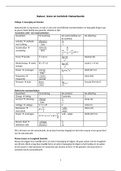Exam (elaborations)
Edexcel A Economics Paper 3 Exam Practice Questions
- Module
- Introduction to economics
- Institution
- PEARSON (PEARSON)
This document is a great way to find your strengths and weaknesses within the different exam topics and a good way to recall information learnt. It covers 3 questions from each topic listed in the specification ranging from theme 1 all the way down to theme 4. This is designed to give insight to t...
[Show more]












